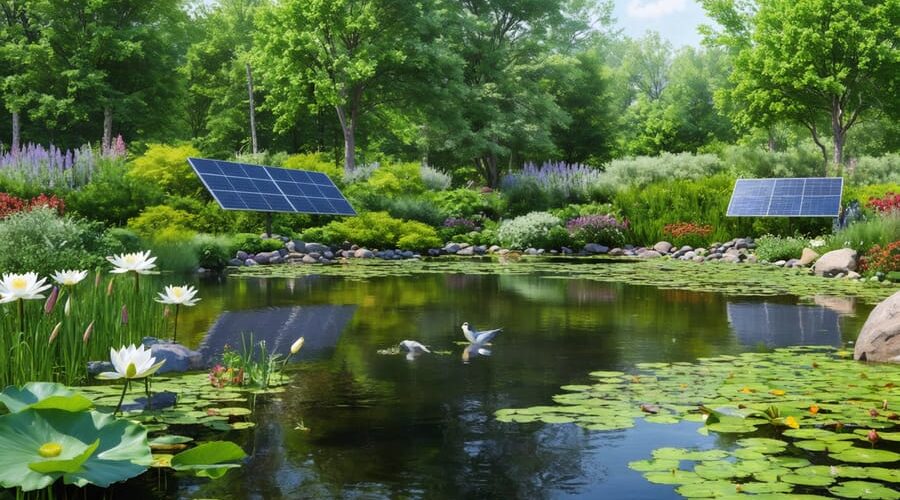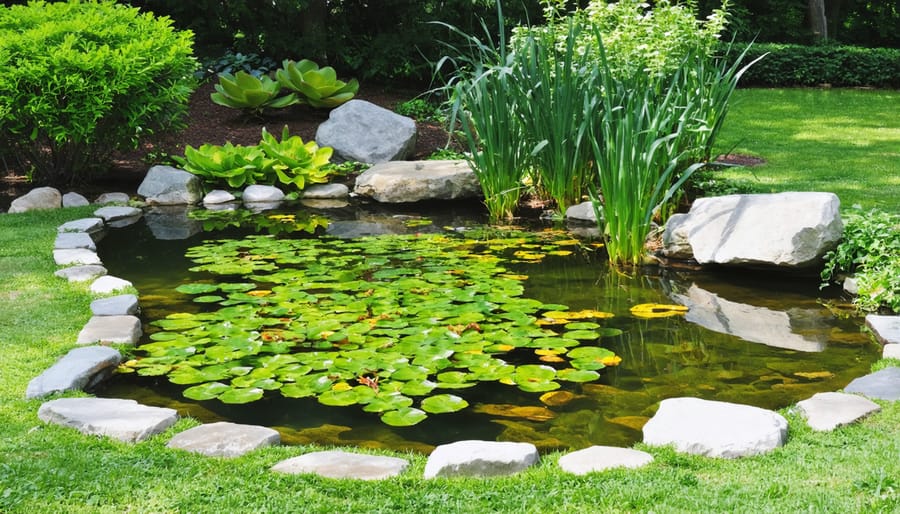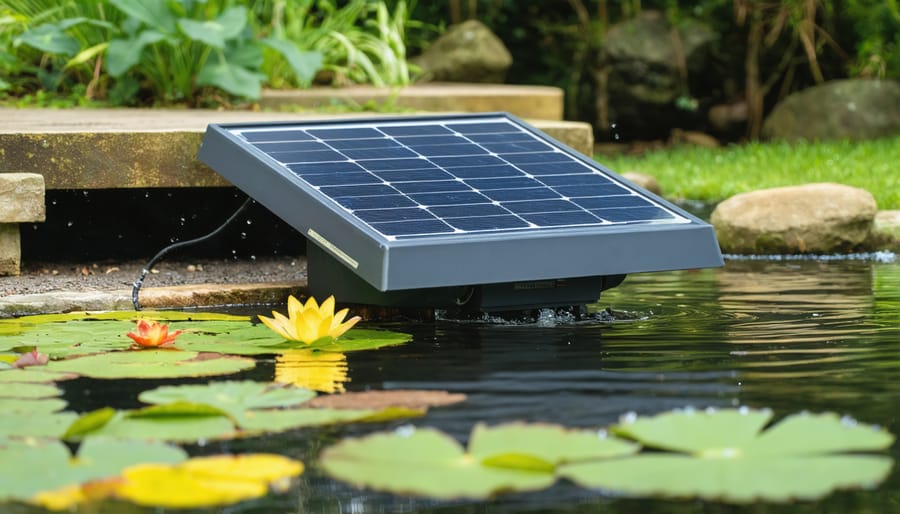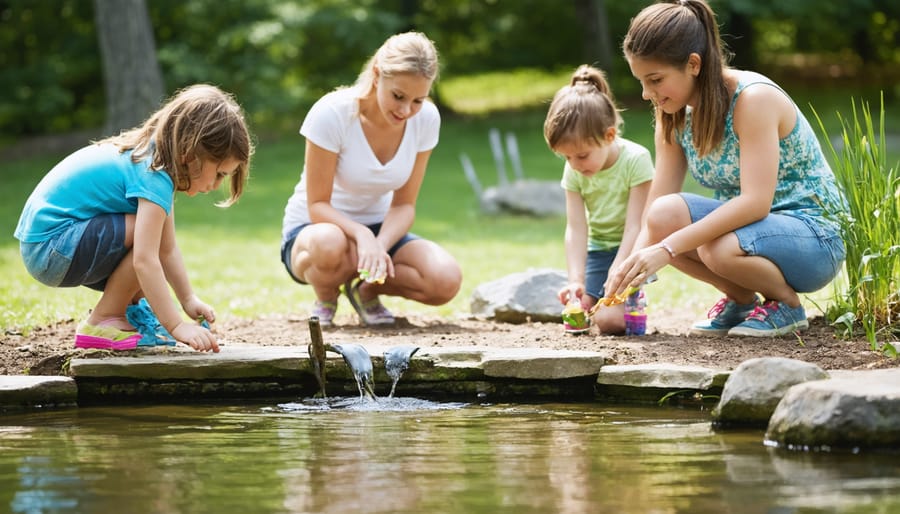
Make Your Pond Thrive: Natural Balance Through Smart Sustainability
Sustainability isn’t just a buzzword – it’s a powerful framework that transforms how we interact with our environment, communities, and resources. The three pillars of sustainability – environmental, social, and economic – provide practical solutions for creating lasting positive impact in everyday scenarios. From neighborhood pond management to large-scale water conservation projects, these pillars work together to ensure our natural resources benefit both current and future generations.
Consider a community pond as a perfect microcosm of sustainable practices: Environmental sustainability shows up in maintaining water quality and supporting native species. Social sustainability emerges through shared recreational spaces and educational programs that bring neighbors together. Economic sustainability manifests in reduced maintenance costs and increased property values through proper management.
Real-world examples demonstrate how these pillars interconnect: A rain garden that filters runoff (environmental) creates a beautiful community gathering space (social) while reducing flood damage costs (economic). Solar-powered aeration systems cut energy expenses (economic) while improving water quality (environmental) and creating better fishing opportunities (social). Native plant installations along shorelines prevent erosion (environmental), provide educational opportunities (social), and minimize long-term maintenance needs (economic).
By understanding and implementing these three pillars, pond owners and water feature enthusiasts can create sustainable ecosystems that benefit both nature and their communities for generations to come.
Environmental Sustainability in Your Pond
Natural Filtration Systems
Natural filtration systems represent a perfect example of sustainability in action, working harmoniously with nature to maintain a thriving pond ecosystem. At its core, this approach uses plants, beneficial bacteria, and natural processes to keep water clean and healthy, eliminating the need for harsh chemicals or energy-intensive equipment.
Aquatic plants like water lilies, rushes, and cattails act as nature’s filters, absorbing excess nutrients and providing shelter for beneficial microorganisms. These plants not only clean the water but also create stunning natural displays that enhance your outdoor space. Beneath the surface, beneficial bacteria break down organic waste, converting harmful compounds into nutrients that plants can use.
The beauty of natural filtration lies in its self-sustaining cycle. Fish waste feeds plants, plants clean the water, and beneficial bacteria maintain the balance. This creates a mini-ecosystem that mirrors nature’s own cleaning processes. For pond owners, this means less maintenance, lower operating costs, and a more environmentally friendly water feature.
To get started with natural filtration, consider adding a mix of submerged, floating, and marginal plants. Create shallow areas where beneficial bacteria can thrive, and introduce native species that are well-adapted to your local climate. Remember, patience is key – natural systems take time to establish, but once they’re running, they’re incredibly efficient and sustainable.

Water Conservation Methods
Implementing effective water conservation strategies is crucial for maintaining an eco-friendly pond. Start by installing a reliable rainwater harvesting system to collect and store natural precipitation. This can be as simple as connecting your gutters to a collection tank or as sophisticated as creating a dedicated catchment area around your pond.
Proper liner installation is essential to prevent water loss through seepage. Choose high-quality, UV-resistant liners and ensure they’re correctly positioned with adequate underlayment to protect against punctures. Pay special attention to seams and edges, using appropriate sealants to maintain water integrity.
To reduce evaporation, consider incorporating floating plants that provide natural shade coverage. Installing a pond cover during peak evaporation periods can also make a significant difference. Strategic placement of water features can help minimize splash-out, while maintaining proper water levels helps optimize circulation and reduces unnecessary water loss.
These methods not only conserve water but also contribute to lower maintenance costs and a healthier pond ecosystem, making your water feature more sustainable in the long run.
Native Species Integration
Incorporating native species into your pond ecosystem isn’t just a trendy choice – it’s a powerful way to support local biodiversity and create a more sustainable water feature. Native plants and fish have evolved alongside local wildlife, forming intricate relationships that benefit the entire ecosystem. These species are naturally adapted to your climate, requiring less maintenance and fewer resources to thrive.
When selecting aquatic plants, opt for indigenous varieties that provide natural filtration and habitat. Native water lilies, rushes, and marginal plants not only look beautiful but also help maintain water quality naturally. These plants work in harmony with local beneficial insects and provide shelter for native wildlife.
For fish selection, local species are ideal as they’re already adapted to your region’s temperature fluctuations and water conditions. They typically require less intervention to maintain healthy populations and are less likely to become invasive if accidentally released into local waterways. This approach creates a self-sustaining ecosystem that supports local wildlife while reducing the need for artificial inputs and ongoing maintenance.
By choosing native species, you’re not just creating a beautiful pond – you’re contributing to the preservation of local biodiversity and ensuring your water feature remains sustainable for years to come.
Economic Sustainability Practices

Energy-Efficient Equipment
Energy-efficient equipment forms the cornerstone of sustainable pond management, offering both environmental and economic benefits. Solar pumps harness the sun’s power to circulate water, eliminating the need for traditional electricity and reducing your carbon footprint. These innovative systems work efficiently during daylight hours, maintaining proper water movement while cutting energy costs significantly.
LED lighting has revolutionized pond illumination, consuming up to 80% less energy than traditional halogen lights while lasting considerably longer. These lights not only create stunning nighttime displays but also operate at cooler temperatures, making them safer for aquatic life and reducing maintenance needs. Color-changing LED options allow you to customize your pond’s appearance throughout the seasons.
Timer systems play a crucial role in optimizing energy usage. By programming your equipment to operate only when needed, you can avoid unnecessary power consumption. For instance, setting circulation pumps to run at reduced capacity during nighttime hours or programming lights to activate only during evening viewing times can substantially reduce energy usage. Smart timer systems can even adjust to seasonal changes automatically, ensuring your pond receives optimal care while minimizing energy waste.
When combined, these three technologies create a powerful foundation for an energy-efficient pond system that supports both environmental sustainability and reduced operating costs.
DIY Maintenance Solutions
Embracing cost-effective pond maintenance starts with simple DIY solutions that anyone can implement. Create your own natural pond cleaner by mixing vinegar and baking soda, which safely removes algae without harming aquatic life. For pond filtration, repurpose plastic containers filled with bio-balls or lava rock to create custom filter media at a fraction of the cost.
Consider making your own fish food using kitchen scraps and garden vegetables, ensuring a sustainable food source while reducing waste. Install a rainwater collection system using recycled barrels to maintain water levels naturally, saving on utility bills and conserving resources.
Regular maintenance becomes more sustainable when you craft your own pond-cleaning tools. A DIY skimmer net made from old window screens and PVC pipe works just as effectively as store-bought versions. For natural weed control, introduce beneficial plants like water lilies that naturally compete with unwanted growth while adding beauty to your pond ecosystem.
These homemade solutions not only reduce environmental impact but also create a more self-sufficient pond system that’s easier on your wallet.
Long-Term Investment Strategies
Investing in durable materials and implementing preventive maintenance are crucial strategies for long-term pond sustainability. Choose high-quality liner materials like EPDP or reinforced PVC that can withstand UV exposure and temperature fluctuations for 15-20 years. Similarly, select energy-efficient pumps and filters made from corrosion-resistant materials to ensure longevity and reduce replacement frequency.
Regular maintenance checks help identify potential issues before they become major problems. Inspect your pond’s edges and liner quarterly for signs of wear, and clean filters monthly to maintain optimal performance. Consider installing protective features like UV-resistant covers for equipment and proper edging to prevent liner deterioration.
Document your maintenance schedule and keep records of equipment purchases and repairs. This helps track the lifespan of different components and plan for future replacements. Remember that spending more upfront on quality materials often results in significant long-term savings through reduced repair costs and extended equipment life.
Create a maintenance fund by setting aside a small amount monthly for future repairs or upgrades. This financial planning ensures you can address issues promptly without compromising your pond’s sustainability goals.
Social Sustainability Elements
Educational Opportunities
Ponds offer incredible opportunities for hands-on environmental education and community engagement. By creating educational programs around your pond, you can help others understand the delicate balance of aquatic ecosystems while promoting sustainability awareness. Schools can use ponds as outdoor classrooms, teaching students about water quality testing, aquatic life cycles, and the importance of wetland conservation.
Consider organizing pond discovery days where children can learn about native fish species, beneficial plants, and the role of beneficial insects in maintaining healthy water systems. These events can include activities like water testing demonstrations, wildlife observation sessions, and sustainable gardening workshops.
Ponds also serve as perfect demonstration sites for sustainable practices. Visitors can learn about natural filtration methods, water conservation techniques, and how to create wildlife-friendly environments. Installing educational signage around your pond helps visitors understand the ecosystem services provided by these water features, from supporting biodiversity to managing stormwater runoff.
For maximum impact, partner with local environmental organizations or schools to develop structured learning programs. Document your pond’s seasonal changes through photography or journaling to create educational resources that showcase the dynamic nature of aquatic ecosystems and their role in environmental sustainability.

Community Engagement
A sustainable pond isn’t just a personal oasis – it’s an opportunity to strengthen community bonds and share environmental benefits. Consider hosting educational workshops where neighbors can learn about aquatic ecosystems and sustainable water management. Local schools might appreciate using your pond for science lessons, giving students hands-on experience with water quality testing and wildlife observation.
Create a community sharing program for excess plants during seasonal divisions. Your flourishing water lilies and marginal plants can beautify other local water features while promoting native species. Partner with local gardening clubs to organize pond tours, showcasing how sustainable water features enhance property value and support local wildlife.
Your pond can serve as a demonstration site for water conservation techniques. Share your experiences with rainwater harvesting and natural filtration systems, inspiring others to adopt eco-friendly practices. Consider offering your space for community events like nature photography sessions or meditation gatherings, helping others connect with water gardens’ therapeutic benefits.
Document and share your pond’s positive environmental impact through social media or local environmental groups. This creates a ripple effect, encouraging more community members to embrace sustainable water feature practices and contribute to local ecosystem health.
Wildlife Habitat Creation
Creating wildlife-friendly spaces in and around your pond is a powerful way to support local biodiversity and enhance environmental sustainability. By incorporating native plants, varying water depths, and natural materials, you can build rich biodiversity that attracts beneficial insects, birds, and small animals.
Start by adding different types of aquatic plants – floating, marginal, and submerged varieties – to create diverse habitats. Include shallow areas and gently sloping banks to allow easy access for wildlife. Natural rock formations and fallen logs provide shelter and basking spots for creatures like frogs and dragonflies.
Consider creating a buffer zone of native plants around your pond to connect it with the surrounding landscape. This natural corridor helps wildlife move safely between different habitats. Adding features like bird baths, insect hotels, and small brush piles near your pond further enhances its value as a wildlife sanctuary.
Remember to maintain chemical-free practices and embrace natural pond management methods to ensure your habitat remains safe and welcoming for all creatures.
As we’ve explored throughout this article, successful pond management relies on the delicate balance between environmental, social, and economic sustainability. These three pillars don’t exist in isolation – they work together like the gears of a well-oiled machine, each supporting and enhancing the others.
When you maintain proper water quality and support local wildlife, you’re not just helping the environment; you’re also creating a more enjoyable space for family gatherings and potentially increasing your property’s value. Similarly, when you invest in energy-efficient pumps and natural filtration systems, you’re reducing both your environmental impact and long-term operating costs.
The social aspects of pond ownership – from sharing gardening tips with neighbors to hosting outdoor gatherings – create a sense of community that often leads to shared resources and knowledge, making pond maintenance more economical and environmentally friendly. This community aspect often results in collective efforts to preserve local ecosystems and water resources.
Remember that sustainability isn’t about achieving perfection in any single area – it’s about finding the sweet spot where all three pillars support each other. Start with small steps in each area: maybe installing a solar pump, adding native plants, or organizing a neighborhood pond tour. As you progress, you’ll find that improvements in one area naturally lead to benefits in the others.
By embracing these interconnected principles, you’re not just creating a sustainable pond – you’re contributing to a larger movement of responsible water feature management that benefits both current and future generations. Your pond becomes more than just a water feature; it becomes a model of sustainable practices that others can learn from and implement in their own backyards.
